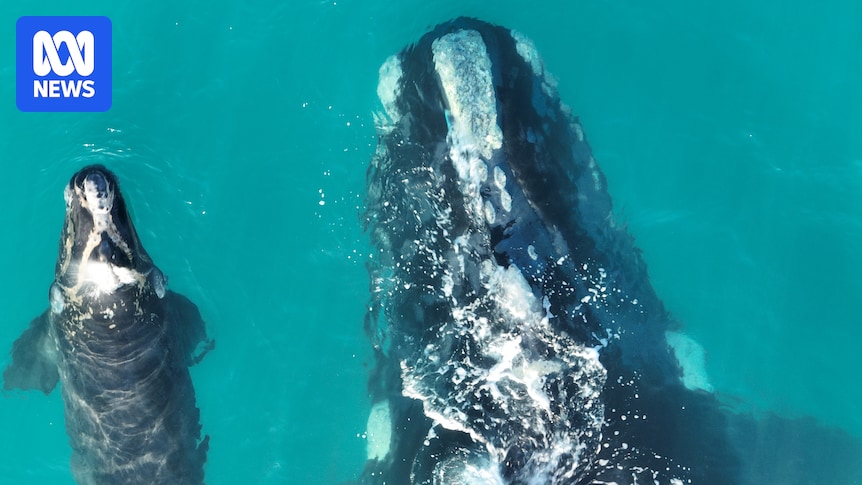Armed with binoculars and notebooks, a group of researchers scramble along the remote cliff edges counting and photographing one of the world’s largest creatures — the majestic southern right whale.
Below the Bunda Cliffs of the Nullarbor Plain, in the clear waters of the Southern Ocean, they have spotted one of the Australian Right Whale Research project’s original mothers — a whale called 3×2 (or Three by two) first photographed in 1991.
She is at least 45 years old and nursing her ninth calf in the Great Australian Bight Marine Park.
She is one of 114 whales and calves, the highest number since 2021, recorded in the Bight this year by researchers from Curtin University, Flinders University, and Current Environmental.
For 34 years, the recovery of the gentle giants has been documented from an initial 20 mothers and calves to now reaching saturation point at their major breeding and calving ground at Head of Bight.
As whale numbers grow after edging dangerously close to extinction, research scientists are calling for better protection as the whales head to other bays along the southern coastline for their winter migration from June to October before heading south to Antarctic waters.
Researchers Claire Charlton and Steve Burnell at the Head of the Great Australian Bight. (Supplied: GABRWS Project)
Growing threats
Curtin University lead researcher Claire Charlton and co-investigator Brigette O’Shannessy said the whales were frequenting new areas.
“Their distribution has expanded, and the whales are re-establishing these new areas such as Sleaford Bay, Encounter Bay, Fowlers Bay, Portland in Victoria, and Geographe Bay in Western Australia,” Dr Charlton said.
“With the increase in whales in our oceans and the increase in marine-based industries — including recreation, tourism, oil and gas, offshore renewables and shipping — the threats the species face also grow.”
She said the marine park had been effective in helping the species recover and scientists were now asking for greater measures to protect the whales along the coast.
“It is certainly a big hot topic around the need for increased protection through marine park areas and the zones within those marine park areas to have legislative protection,” Dr Charlton said.
“The states and the Commonwealth are actively making movements in that area as well.”
Researchers at Head of Bight count and record the number of whales in the nursery area daily. (Supplied: Australian Right Whale Research)
Dr Charlton said the South Australian government had committed to investigating increased protection for southern right whales within coastal waters, and in Western Australia, the state government was also working on greater protections.
Puzzling birth rate
While whale migration numbers are up, scientists are puzzled by how much birth rates have slowed.
The average breeding cycle for mothers is every three years, but according to new data that has changed to every four to five years.
“We’ve got some great data, and we’ve got a recovering population, and while we are seeing changes in their calving intervals we’re also seeing this in other areas, such as South Africa, Argentina, New Zealand, Brazil,” Dr Charlton said.
A group of southern right whales socialising in the shallow waters at Fowlers Bay, South Australia. (Supplied: Hannah Edwards, Australian Right Whale Research)
“It is a really critical time to sort of pull that data together, pull that information, and see that it’s having an impact for policy and management.
“When we look at, for example, the sister species, the North Atlantic right whales, that have had a really hard time in very populated waters around the US and Canada, their population has been shown to be in decline due to human-induced mortalities.
“We’ve got a real opportunity to do things differently and to see a different result.”
Researcher Bridgette O’Shannessy at Fowlers Bay. (Supplied: Australian Right Whale Research)
Dr Charlton said a big part of the research was understanding the drivers of change, and the changes in birth rates could be related to climate issues.
“Some of the theories might be that a warming ocean is causing less prey about; less ice means less prey availability,” Dr Charlton said.
“Less prey availability could result in reduced or compromised health, which could lead to females either not falling pregnant or having unsuccessful pregnancies.
“So that’s why we think they’re probably skipping years from a three-year to a four or even a five-year interval.
“If they have unsuccessful pregnancies or calf mortalities, then they’re likely to extend those calving intervals.”
Citizen scientists like Marianne Stockham contribute information and photograph whales on Eyre Peninsula. (ABC Eyre Peninsula: Jodie Hamilton)
Dr Charlton said the whales were a great success story and the heart and soul of the research program was dependent on collaborations with the local community, citizen scientists, the Yalata Aboriginal people, and the people of the Far West Coast as well as tourists and volunteers.
Members of the public can contribute images to the Australasian Right Whale Photo-Identification Catalogue (ARWPIC), which is an online platform developed to share images and sightings of southern right whales and already has more than 6,500 photos.
